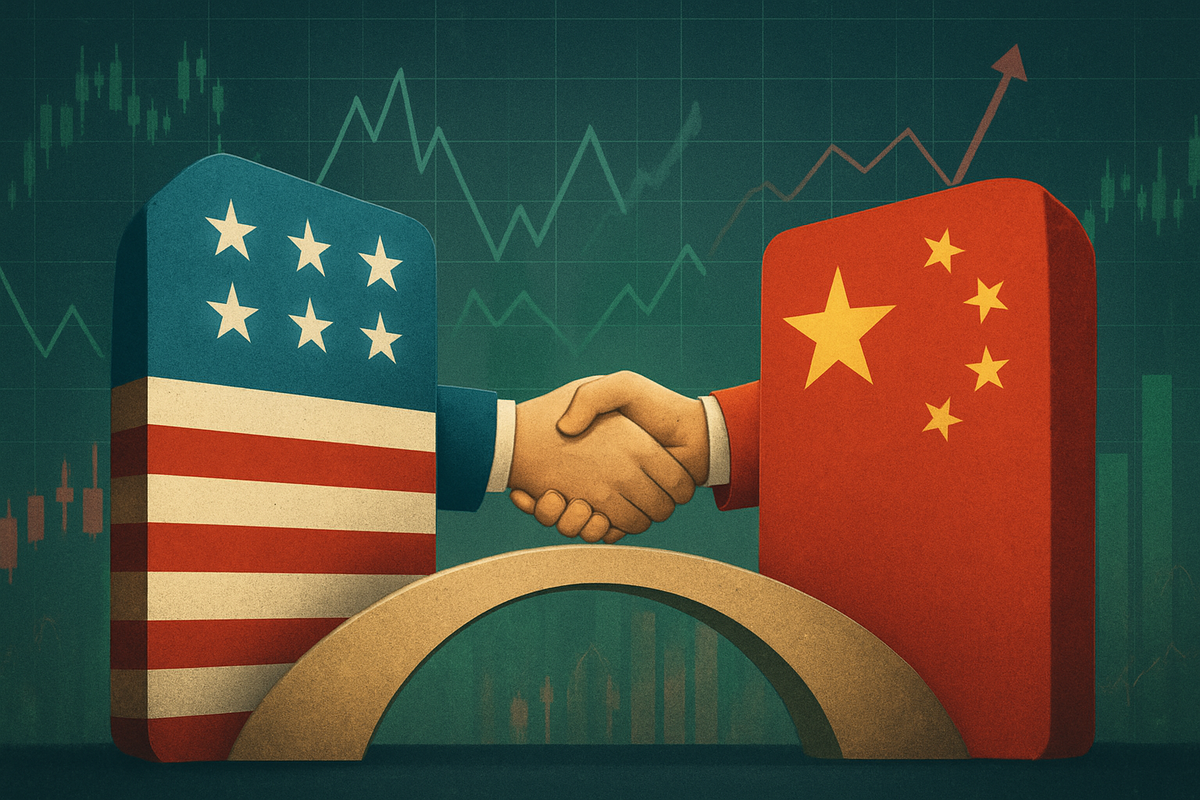Financial News
Geopolitical Tensions and Trade Truces: A New Era for Stock Market Volatility

In an increasingly interconnected yet fractured world, geopolitical events have cemented their role as pivotal drivers of stock market trends and investor sentiment. From military conflicts to diplomatic breakthroughs, international relations can trigger immediate and profound shifts in global financial landscapes. A prime example of this dynamic is the recent US-China trade truce, announced on October 30, 2025, which offered a tangible illustration of how political developments directly influence market stability, corporate valuations, and strategic investment decisions. This truce, coming after years of trade friction, underscores a "new normal" where geopolitical risks are not just external factors but integral components shaping economic forecasts and market behavior.
The financial markets, inherently sensitive to uncertainty, often react with heightened volatility when geopolitical tensions escalate or de-escalate. Investor confidence can be swiftly eroded by trade wars, sanctions, or political instability, leading to significant asset price fluctuations. Conversely, signs of de-escalation, such as the US-China trade agreement, can inject a wave of optimism, spurring market rallies and encouraging a re-evaluation of risk. Understanding these intricate connections is crucial for navigating the complexities of modern financial markets, as the interplay between global politics and economic performance becomes ever more pronounced.
The US-China Trade Truce: A Respite from Economic Headwinds
The recent US-China trade truce, forged on October 30, 2025, during the APEC Summit in Busan, South Korea, marked a significant turning point in the protracted trade dispute between the world's two largest economies. This agreement, a culmination of intensive negotiations, aimed to de-escalate tensions that had cast a long shadow over global supply chains and economic growth for years. Key provisions of the truce included a substantial reduction in tariffs from both nations. The United States committed to lowering its overall tariffs on Chinese imports from 57% to 47%, with a particular focus on halving "fentanyl-related tariffs" from 20% to 10% in a gesture aimed at addressing critical public health concerns.
In reciprocation, China agreed to crucial economic concessions. Notably, Beijing committed to delaying previously threatened export limits on rare earths for one year, a move that assuaged concerns about potential disruptions to critical technology supply chains. Furthermore, China pledged to resume significant purchases of US agricultural products, particularly soybeans, with a commitment to buy a minimum of 25 million metric tons annually for the next three years, offering a much-needed boost to American agricultural exports, which had been severely impacted by the trade war. This two-way concession demonstrated a mutual desire to stabilize economic relations and foster a more predictable environment for international trade. The US also agreed to suspend its Section 301 investigation into Chinese shipbuilding for one year, with China reciprocating by suspending its countermeasures.
The immediate reaction from global financial markets was overwhelmingly positive. US stock indices, including the Dow Jones Industrial Average (DJIA), Nasdaq Composite (NDAQ), and S&P 500 (SPX), surged to record highs on the news, reflecting investor optimism about reduced trade friction and anticipated Federal Reserve interest rate cuts. This bullish sentiment was mirrored across global stock markets, which also saw a general uplift. Sectors particularly vulnerable to trade tensions, such as chipmakers, experienced significant gains. Companies like Broadcom (AVGO), Nvidia (NVDA), Qualcomm (QCOM), and AMD (AMD) saw their stock prices increase, benefiting from the prospect of stabilized supply chains and clearer market access. Conversely, rare earth stocks experienced a downturn amid speculation that China might indeed postpone or reconsider its export controls, highlighting the nuanced impacts of such agreements. Commodity markets also reacted, with gold prices, a traditional safe-haven asset, typically falling amid easing trade tensions, while oil prices showed less conviction about demand.
Corporate Fortunes: Winners and Losers in the Trade Truce
The US-China trade truce has created a complex web of advantages and disadvantages for various industries and public companies, reflecting the deep integration and, at times, fierce competition between the two economic giants.
The agriculture sector, particularly US soybean and corn farmers, stands as a clear winner. During the trade war, China, a historically massive buyer, shifted purchases away from the US, leading to billions in lost revenue. With China's commitment to resume large-scale purchases, agricultural giants like Archer Daniels Midland (ADM: NYSE) and Tyson Foods (TSN: NYSE), heavily involved in agricultural exports, are poised for significant benefits from increased demand and stabilized commodity prices.
In the technology and semiconductor industry, the truce brings a mixed bag of relief and ongoing challenges. Companies like Apple Inc. (AAPL: NASDAQ), with its extensive manufacturing base in China, could save billions from reduced tariffs on electronics imports, potentially translating to over $2 billion annually for Apple and its customers. Chipmakers such as NVIDIA Corp. (NVDA: NASDAQ), Micron Technology (MU: NASDAQ), Intel Corp. (INTC: NASDAQ), Qualcomm Inc. (QCOM: NASDAQ), and Cisco Systems Inc. (CSCO: NASDAQ), which have substantial sales exposure to China, are expected to benefit from easing export controls and reduced trade tensions, helping to alleviate supply chain disruptions. The agreement also included discussions about allowing companies like Nvidia to sell advanced AI chips to China, although the most advanced Blackwell chips were excluded. However, the underlying strategic competition in technology, particularly regarding advanced chips and AI, remains unresolved, and China's push for technological self-sufficiency could diminish its long-term reliance on US components.
The automotive industry also sees potential benefits. Automakers with significant sales and production in China, such as General Motors Company (GM: NYSE) and Ford Motor Company (F: NYSE), could experience improved market conditions due to diminished tariff threats. Tesla Inc. (TSLA: NASDAQ), while initially impacted by tariffs on its US-made vehicles sold in China, could also see eased cost burdens. Conversely, Chinese auto-parts manufacturers have shown caution in their US investment plans due to tariff volatility, indicating continued uncertainty.
Retailers and consumer discretionary companies that heavily import from China, including apparel, footwear, and electronics, are likely to benefit from lower input costs due to reduced tariffs. Companies like Nike Inc. (NKE: NYSE), Under Armour Inc. (UAA: NYSE), Foot Locker Inc. (FL: NYSE), Dick's Sporting Goods Inc. (DKS: NYSE), Amazon.com Inc. (AMZN: NASDAQ), and Target Corp. (TGT: NYSE) could see improved margins or offer more competitive pricing. However, domestic manufacturers in the US competing directly with Chinese imports might face renewed price pressure. Finally, logistics and shipping companies such as FedEx Corporation (FDX: NYSE) and United Parcel Service, Inc. (UPS: NYSE) could see a rebound in international freight volumes as trade flows become more predictable.
Wider Significance: A Tactical Pause in a Strategic Rivalry
The US-China trade truce, while providing immediate relief, is widely viewed as a tactical de-escalation within a broader, ongoing strategic rivalry between the two global superpowers. This event fits into a larger trend of increasing economic nationalism and a shift where global commerce is increasingly intertwined with geopolitical strategy. Tariffs and trade policies are now potent instruments of leverage, reflecting a recognition that the economic costs of unbridled confrontation were becoming unsustainable for both nations.
The agreement's impact extends beyond direct participants, creating ripple effects across global supply chains and various regions. The temporary stabilization offered by the truce, particularly the one-year suspension of Chinese rare earth export curbs, is crucial for global technology supply chains, given China's near-monopoly in rare earth processing. However, businesses are still advised to reinforce supply chain resilience, as the stability is not guaranteed. Many multinational corporations have already adopted a "China+1" strategy, diversifying manufacturing hubs to countries like Vietnam, India, and Mexico, a trend that may continue, albeit at a slower pace. Other countries that benefited from trade diversion during the tariff wars might see some of that advantage diminish.
From a regulatory and policy perspective, the truce involves significant tariff adjustments, with the US reducing its overall tariffs on Chinese imports and China reciprocating with reductions on US products and a delay in rare earth export restrictions. The suspension of US export restrictions and Section 301 investigations signals a temporary halt to aggressive policy tools, though these could be reactivated. This creates an environment of regulatory uncertainty for businesses. The agreement also highlights a fragmented US trade strategy, likely to remain complex and prolonged, with a long-term goal for the US to limit China's technological advancements in strategic sectors like semiconductors and pharmaceuticals, while China aims for high-tech self-reliance.
Historically, trade disputes between major economic powers are not new. Precedents ranged from the Smoot-Hawley Tariff Act of 1930, which exacerbated the Great Depression, to the US-Japan trade wars of the 1980s over automobiles and electronics, and even the "Banana Wars" between the US and EU. However, the scale and intertwined nature of the US-China relationship make this current conflict unique, encompassing a broader array of issues beyond traditional trade, such as state-sponsored industrial policies, cybersecurity, human rights, and technology transfer. The current truce, therefore, is seen by many as a tactical pause in an ongoing competition, rather than a fundamental shift in strategic rivalry.
What Comes Next: Navigating a Future of Cautious Engagement
The US-China trade truce, while offering immediate market relief, sets the stage for a future characterized by both cautious de-escalation and persistent strategic competition. In the short term, the agreed-upon tariff adjustments and China's commitment to delay rare earth export controls for one year provide a critical breathing room for industries dependent on these trade flows. The resumption of large-scale US agricultural purchases also offers immediate benefits to American farmers. Markets are likely to experience a period of stabilization and positive sentiment, shifting from crisis management to opportunity assessment. Diplomatic re-engagement, evidenced by reciprocal visits and intensive negotiations, suggests a willingness to maintain dialogue at the highest levels.
However, the long-term outlook remains complex. Experts widely agree that core tensions over technology dominance, intellectual property, industrial subsidies, and strategic influence remain unresolved. This truce is largely viewed as a "tactical truce amid a strategic rivalry" that will continue to shape the relationship. The trend toward supply chain realignment and "decoupling" in certain strategic sectors is expected to continue, albeit at a more measured pace, as businesses seek to diversify and build resilience against future disruptions. The potential for renewed tensions remains high, driven by factors such as perceived non-compliance, domestic political pressures, or unforeseen geopolitical events.
For businesses, strategic pivots are essential. Companies are likely to continue or accelerate the diversification of their supply chains, adopting a "China Plus One" strategy to establish production facilities in other countries. Increased investment in automation and advanced manufacturing may also be pursued to reduce reliance on labor-intensive production vulnerable to geopolitical shifts. US firms operating in China will need to navigate persistent regulatory uncertainty, inconsistent interpretation of laws, and the potential for new export controls. Governments, in turn, must balance economic interests with national security, particularly concerning critical technologies and materials. Developing domestic capabilities for rare earths and semiconductors will likely remain a priority, alongside robust diplomatic engagement and multilateral cooperation.
Market opportunities may emerge in the agricultural sector, in non-tariffed sectors, and through increased US export opportunities aimed at balancing the trade deficit. However, significant challenges persist, including lingering tariffs, intensified competition from state-backed Chinese firms, persistent issues with intellectual property protection, and the underlying vulnerability of global supply chains due to China's dominance in critical materials. The most likely scenario is one of cautious de-escalation, characterized by a cyclical pattern of temporary truces followed by renewed disputes, implying that businesses and governments must continuously adapt to an unpredictable environment.
Comprehensive Wrap-up: A Fragile Equilibrium
The US-China trade truce, formalized on October 30, 2025, represents a pivotal moment in global financial markets, offering a much-needed respite from escalating trade tensions. The key takeaways from this agreement include significant tariff reductions from both sides, China's commitment to delay rare earth export curbs for one year, and renewed large-scale purchases of US agricultural products, particularly soybeans. These measures have injected a sense of cautious optimism into markets, leading to relief rallies and a positive shift in investor sentiment, particularly benefiting sectors like agriculture, technology, and logistics.
Moving forward, the market assessment is one of guarded hope. While immediate economic headwinds have eased, the underlying structural issues driving the US-China strategic rivalry remain largely unaddressed. This truce is widely perceived as a "tactical pause" rather than a definitive resolution, meaning that while volatility may decrease in the short term, the potential for future escalations persists. The lasting impact of this event will likely be a continuation of the trend toward supply chain diversification and a greater emphasis on national economic security over pure efficiency. The relationship between the two economic superpowers will continue to be the most critical bilateral relationship, profoundly influencing global stability and prosperity.
Investors should approach the coming months with a balanced and vigilant perspective. It is crucial to monitor China's adherence to its commitments, particularly regarding agricultural purchases and the rare earth export delay, given past instances of unfulfilled targets. Investors should also remain acutely aware of the unresolved core disagreements over technology, intellectual property, and industrial subsidies, as these are potent sources of future friction. Favoring companies that have diversified operations and robust supply chains will be a prudent strategy. Paying close attention to sector-specific developments, global economic indicators, and the frequency and outcomes of high-level diplomatic engagements will provide valuable insights into the stability and direction of this critical bilateral relationship. The "new normal" is one where geopolitical risks are integrated into investment strategies, demanding agility and a long-term perspective to navigate the intricate interplay of politics and markets.
This content is intended for informational purposes only and is not financial advice
More News
View More




Recent Quotes
View More
Quotes delayed at least 20 minutes.
By accessing this page, you agree to the Privacy Policy and Terms Of Service.



